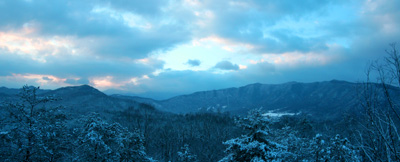Last week’s mild weather energized us for spring fishing, but winter isn’t over just yet. We woke up yesterday morning to see the following scene out of our window.

View of Rich Mountain and Dry Valley from our home in Townsend, TN
The temperature struggled to reach 30 degrees and the three inches of snow we received is still here today. It was a bit of a jolt since it was sunny and 55 on Saturday. Charity had a Casting For Recovery meeting and our daughter went to the movies with her grandmother so I hitched up the drift boat and headed over to Calderwood Lake. My old fishing buddy Andrew Sonner came along.
Neither of us have done much fishing on Calderwood in the winter and we were reminded why. The fishing wasn’t just slow, it was dead; at least with a fly rod. There was one other boat on the lake and they were trolling. The one time we passed them they picked up a rainbow trout.
We could have gone to a number of other places and probably gotten a number of hook ups, but that’s not really the reason we took off for Calderwood. First of all I had been in my drift boat only once in the past few months and Andy hasn’t really done much fishing at all since the holidays. I also wanted to fire up my boat’s outboard, but there’s also the issue of the beauty and solitude that you find on Calderwood Lake.
Springlike temperatures are due to return this week and we’re officially on “Quill Gordon Watch 2009”. Quill Gordon and Blue Quill mayflies are the first good hatch of the season that get fish rising in the Smoky Mountains. We’ve got some olives and brown stoneflies flitting about right now along with some dun caddis, but none of these get the fish up reliably. Once the water warms up in late February or early March these insects begin to hatch and will continue to do so regardless of what the weather does after they begin.
Last year the hatches started around March 10 but we’ve seen them begin as early as February 25. I even saw a few around February 15 in the early 1990’s on Citico Creek. We’ll keep you posted.
Tailwater flows look like TVA is moving into their spring mode as well. Generation schedules are cutting back and the rivers are getting more fishable. Every spring TVA allows the reservoirs to fill and they have to cut generation. This usually lasts until around Memorial Day. After that flows are loosely based on rainfall. Dryer years will have lower flows and wetter years have higher flows, but the rivers remain fishable most of the time in the summer.
